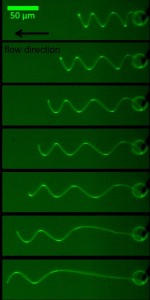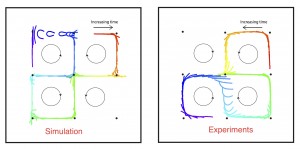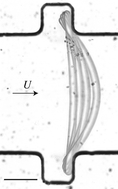Propulsion of micro-organism is induced by the motion of appendices like cilia or flagella whose motion in the surrounding flow generates the propulsive forces. At these small scales, the fluid dynamics is dominated by viscous forces a regime quantified by low Reynolds numbers. Fluid-structure interaction describes situations where a deformable object is deformed and/or transported by a flow. The presence of the object will perturb the flow and this coupling is non trivial. Many theoretical and numerical works have been developed these past years to understand these phenomena but only few experimental studies have been carrie out mainly due to the lack of controlled experimental systems. During the past years we studied different model situations where the properties of both the objects (mainly size and elasticity) and the flow are well-controlled.
This work is done on a daily collaboration with Anke Lindner (PMMH, ESPCI).
External collaborations:
- Experimental Collaborations: Al Crosby (UMass, USA), Camille Duprat (LadHyX, Palaiseau, France)
- Numerical/theoretical Collaborations: Michael Shelley (Flatiron Institute & NYU, USA), David Saintillan (UCSD, USA), Brato Chakrabarti (Flatiron Institute, NY USA), Blaise Delmotte (LadHyX, Palaiseau, France)
Current PhD students:
Andrea de la Sen (2021-2024),
Alumni:
Zhibo Li (2019-2023), Francesco Bonnacci (PostDoc 2019-2022), Lucas Prévost (2018-2021), Jean Cappello (2016-2019), Francesca Tesser (2017-2019), Marine Daiëff (2015-2018), Yanan Liu (2014-2018), Nawal Quennouz (2009-2013), Elie Wandersman (PostDoc 2007-2008)
You will find illustrations of the different situations we have studied so far. More info by clicking on the images!!



 Home
Home